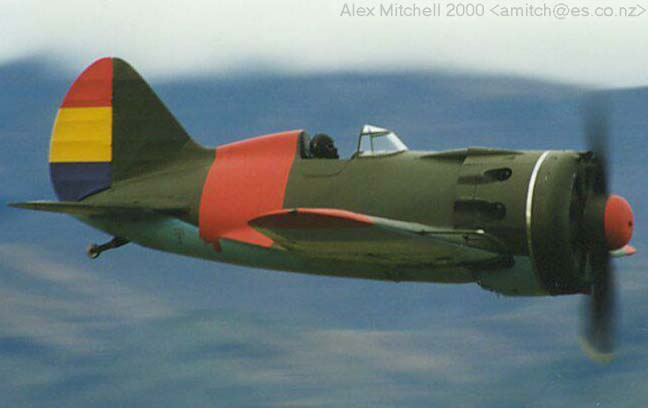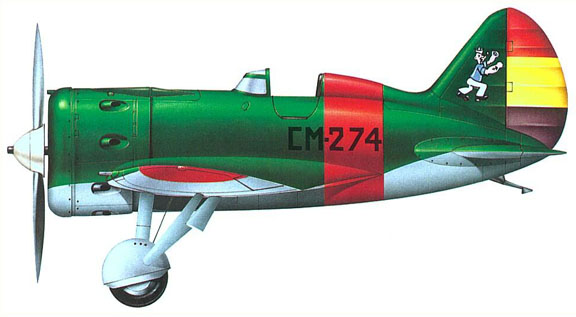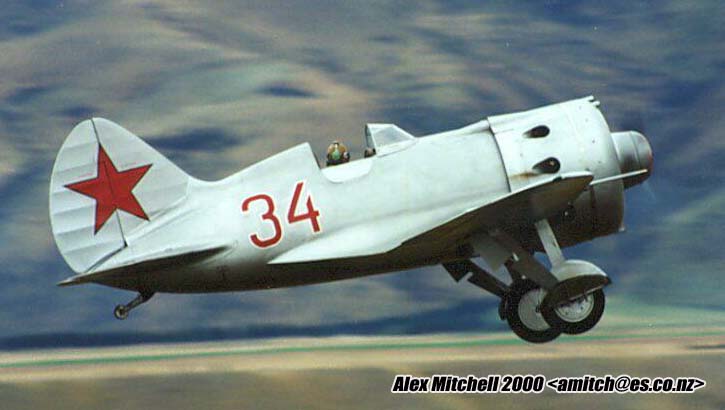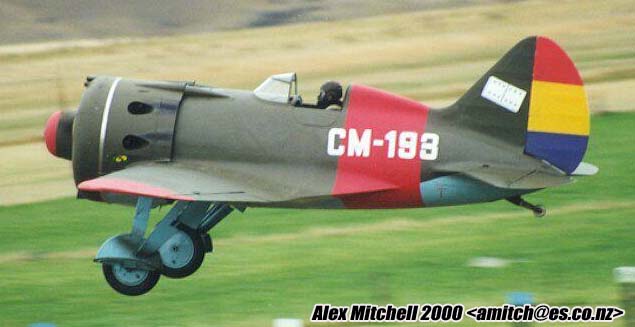|
|



|
Type: Single-Seat Fighter Origin: Polikarpov First Flight: December 31, 1933 Service Delivery: Early 1934 Final Delivery: Late 1942 Number Produced: 8,644 Single Seat: 7,005 Two Seat: 1,639 Powerplant: Model: Shvetsov M-62 Model: 9-Cylinder air cooled Radial Number: One Horsepower: 1,000 hp Fuel: Capacity: 56 Imperial Gallons. Dimensions: Wing span: 29 ft. 1¼ in. (8.88m) Length: 19 ft. 9¾ in. (6.04m) Height: 7 ft. 10¾ in. (2.41m) Wing Surface Area: 161 Sq. Ft. Weights: Empty: 3,252 lbs. (1475 kg) Typical: 4,215 lbs. Max. Take-Off: 4,546 lbs. |
Performance: Maximum Speed: 326 mph at sea level 304 mph (490 km/h) at 3,000m (9,845 ft.) 286 mph at 14,765 ft. Economic cruise speed: 186 mph Initial climb: N/A Service Ceiling: 31,070 ft. (9470m) Range: Internal Fuel: 250 miles (With two 22 gallon aux. tanks): 435 miles Armament: Two 7.62mm ShKAS machine gun in fuselage Ammunition: 450 r.p.g. Two 7.62mm ShKAS machine gun in wings Some variants replace wing MG's with Two 20mm ShVAK cannon with 90 r.p.g. Bomb Load: Underwing racks for up to 441 lb. (200kg) of bombs or up to six RS-82 rockets. Avionics: RSI-1 or RSI-3 radio |

|
Design and development - Source: Wikipedia While working on the Polikarpov I-15 biplane, Nikolai Nikolaevich Polikarpov began designing an advanced monoplane fighter. It featured cutting-edge innovations such as retractable landing gear and a fully enclosed cockpit, and was optimized for speed with a short stubby fuselage (similar to Gee Bee R-1) and a Wright Cyclone radial engine in a NACA cowling. The resulting aircraft had a fuselage built from fabric-covered plywood over pine stringers. The wing was built from steel tubing covered in sheet duralumin and fabric, the tail was aluminum tubing with fabric covering. The main gear was fully retractable by a hand-crank. Another modern feature were the ailerons which ran almost the entire trailing edge of the wing and also operated as flaps by drooping 15°. The armament consisted of a pair of 7.62 mm (0.30 cal) ShKAS machine guns in the wings. The aircraft was small, light, and simple to build. Full-scale work on the TsKB-12 prototype began in June 1933 and the aircraft was accepted into production on 22 November 1933, a month before it ever took to the air. Unlike the original aircraft described above, this one was of full aluminum construction, but had an open cockpit. In fact, the I-16 is the world's first all-metal, cantilever-winged monoplane fighter with retractable landing gear. Due to shortage of Curtiss-Wright Cyclone engines Polikarpov was asked to settle for the less powerful M-22 (Soviet-built Bristol Jupiter) with 335 kW (450 hp). This was deemed acceptable because the projected top speed still exceeded 300 km/h (185 mph). The M-22 powered TsKB-12 first took to the air on 30 December 1933 with the famous Soviet test pilot Valery Chkalov at the controls. The second TsKB-12 with a Cyclone engine and three-bladed propeller flew in January of the following year. Initial government trials in February 1934 revealed very good maneuverability but the aircraft did not to lerate abrupt control inputs. Thus the TsKB-12 was deemed dangerous to fly and all aerobatics were forbidden. The M-22 version was preferred due to vibration of the Cyclone-powered aircraft. Pilots commented early on about difficulty in climbing into the cockpit, a trait that persisted through I-16's service life. Before continuing test flights the designers had to answer the question of spin behavior. Wind tunnel testing suggested that TsKB-12 with its short tail would enter an unrecoverable flat spin, but real-life trials were necessary to confirm this. Since Cyclone engines were rare it was decided to risk the M-22 prototype for this purpose. On 1 March and 2 March 1934, Chkalov performed 75 spins and discovered that the aircraft had very benign stall behavior (dipping a wing and recovering without input from the pilot when airspeed increased) and intentional spins could be easily terminated by placing controls in the neutral position. The stories of vicious spin behavior of the I- 16 perpetuated in modern literature is unfounded (perhaps extrapolated from Gee Bee experience). I-16's stablemate, in fact, the biplane Polikarpov I-153, had much worse spin characteristics. Service trials of the new fighter, designated I-16, began on 22 March 1934. The M-22 prototype reached 359 km/h (223 mph). The manually-retracted landing gear was prone to jamming and required considerable strength from the pilot. Most of the test flights were performed with the gear extended. On 14 April 1934, the Cyclone prototype was damaged when one of the landing gear legs collapsed while it was taxiing. On 1 May 1934, the M-22 prototype participated in the flyover of the Red Square. The third prototype with a Cyclone engine incorporated a series of aerodynamic improvements and was delivered for government trials on 7 September 1934. The top speed of 437 km/h (270 mph) no longer satisfied the Air Force, who now wanted the experimental Nazarov M-58 engine and 470 km/h (290 mph). In the meantime the M-22 powered version entered production at Factory 21 in Nizhny Novgorod and Factory 39 in Moscow. Because it was the fourth aircraft produced by these factories it received the designation I-16 Type 4. A total of 7,005 single-seat and 1,639 two-seat trainer versions were produced.
 Initial service experience revealed that the ShKAS machine guns had a tendency to jam. This was the result of the guns being installed in the wings upside-down to facilitate the fit. The problem was addressed in later modifications. Evaluations from pilots confirmed the experience with prototypes. Controls were light and very sensitive, abrupt maneuvers resulted in spins, and spin behavior was excellent. A barrel roll could be performed in under 1.5 seconds (roll rate over 240 degrees/second). The machine guns were fired via a cable and the required effort, coupled with sensitive controls, made precision aiming difficult. The rear weight bias made I-16 easy to handle on unprepared airfields because the aircraft was rather unlikely to flip over the nose even if the front wheels dug in. The canopy tended to become fouled with engine oil and the moving portion was prone to slamming shut during hard maneuvers which caused many pilots to fix it in the open position. The start of Spanish Civil War in 1936 saw pleas from the Republican forces for fighter aircraft. After receiving payment in gold, Joseph Stalin dispatched around 500 I-16 Type 5s and Type 6s. The aircraft immediately began dominating the Heinkel He 51, Arado Ar 68, and Fiat CR.32 biplanes, and remained unchallenged until the introduction of the Messerschmitt Bf 109. The Nationalists nicknamed the stubby fighter "Rata" (Rat), while the Republicans lovingly called it "Mosca" (Fly). Several aviation publications called the new Soviet fighter a "Boeing" due to the incorrect assumption that it was based on the Boeing P-26's design. Several aircraft were lost after structural failure of the wings which was quickly remedied. Heavy machine gun bullets sometimes penetrated the armored backrest and fuel tanks occasionally caught fire in spite of being protected. The hot Spanish climate required addition of oil radiators and dust adversely affected the lifespan of the engines. Although some air craft accumulated up to 400 hours of flying time, the average life of an I-16 was 87 days, of which one sixth was spent on maintenance. The biggest complaint in service was the light armament of only two 7.62 mm (0.30 cal) machine guns. This was urgently addressed with Type 6 which added a third ShKAS in the bottom of the fuselage. The four-gun Type 10 was nicknamed "Super Mosca" or simply "Super." Another 250 I-16 Type 10 were supplied to China. This model added a second set of 7.62 mm (0.30 cal) ShKAS guns, armor behind the pilot, and had a slightly upgraded 560 kW (750 hp) M-25 engine. In 1939, these aircraft fought against the Japanese, beating the Nakajima Ki-27 and matching the Mitsubishi A5M. Further large scale action took place in fighting between the Soviet Union and Japan in the Battle of Khalkhin Gol in 1939. The Imperial Japanese Navy introduced the A6M Zero in 1940, which swept the I-16 from the skies. Further attempts were made to upgrade the firepower of the plane using 20 mm (0.8 in) ShVAK cannons. Pilots loved the results, but the cannons were in short supply and only a small number of I-16 Type 12, 17, 27, and 28 were built. The cannons adversely affected performance with the 360° circle time increasing from 15 seconds in Type 5 to 18 seconds. Type 24 replaced the skid with a tailwheel and featured the much more powerful 670 kW (900 hp) Shvetsov M-63 engine. Type 29 replaced two of the ShKAS guns with a single 12.7 mm (.50 cal) UBS. Types 18, 24, 27, 28, and 29 could be equipped to carry RS-82 unguided rockets. A 1939 government study found that I-16 had exhausted its performance potential. Addition of armor, radio, battery, and flaps during the aircraft's evolution exacerbated the rear weight distribution to the point where the aircraft required considerable forward pressure on the stick to maintain level flight and at the same time developed a tendency to enter uncontrolled dives. Extension and retraction of the landing flaps caused a dramatic change in the aircraft attitude. Accurate gunfire was difficult. By 1941 the I-16 was still the most numerous Soviet fighter and made up about two-thirds of the VVS. The Red Army pilots nicknamed the plane Ishak (Russian: ????, Donkey) because it was similar to the Russian pronunciation of "I-16." Although I-16 performance was generally inferior to the Messerschmitt Bf 109, especially at high altitude, skilled pilots took advantage of its superior horizontal maneuverability and liked the aircraft enough to resist the switch to more modern fighters. In combat, the Bf 109 could escape from the I-16 in a dive since the stubby fighter had a terminal dive speed of 530 km/h (330 mph). The need for fighters was nevertheless so desperate that production continued during the early years of the war. About half of all produced I-16s were still in service in 1943, when they were finally replaced. Specially modified I-16 were used in the Zveno parasite aircraft experiments using the Tupolev TB-3 mothership.
 I-16 Type 1 - Pre-production trial version, M-22 (Bristol Jupiter) engine, 335 kW (450 hp), 30 built. I-16 Type 4 - First production version, Wright R-1820 Cyclone engine. I-16 Type 5 - Shvetsov M-25 (based on Wright R-1820 Cyclone) engine, 520 kW (700 hp), most numerous version with over 3,000 built. I-16 Type 6 - A third ShKAS machine gun added to the bottom of the fuselage, 30 built. I-16 Type 10 - Four ShKAS machine guns, a more traditional windscreen replaced the troublesome opening canopy, reflector gunsight added, greater surface of the wing covered with duralumin, M-25V engine with 560 kW (750 hp). I-16 Type 12 - Two ShKAS machine guns and two 20 mm ShVAK cannons in the wings. I-16 Type 17 - Synchronized ShKAS moved to the fuselage, ShVAK kept in the wings, M-25V engine, notched underside of the fuselage to accept retractable skis. I-16 Type 18 - Type 10 with Shvetsov M-62 engine with a two-speed turbosupercharger, 620 kW (830 hp). I-16 Type 20 - Four ShKAS, first version capable of carrying underwing fuel tanks with 93 L (25 US gal) capacity based on tanks used on the Japanese Nakajima Ki-27, 80 built. I-16 Type 24 - Four ShKAS, landing flaps replaced drooping ailerons, tailwheel added, second cockpit door added on the starboard side, Shvetsov M-63 engine, 670 kW (900 hp), 934 built. I-16 Type 27 - Type 17 with M-62 engine. I-16 Type 28 - Type 24 with two ShKAS and two ShVAK. I-16 Type 29 - Two synchronized ShKAS in the nose and a single 12.7 mm (0.50 cal) UBS in the bottom of the fuselage, no wing guns, shorter main landing gear with wider track, M-63 engine, 650 built. I-16 Type 30 - Re-entered production in 1941-1942, M-63 engine. I-16P - Cannon-armed prototype, entered production as Type 12. I-16Sh (TsKB-18) - Ground attack version with an M-22 engine, fully armored cockpit (a first for Soviet aircraft), four ShKAS machine guns and 100 kg (220 lb) of bombs, one built. Two additional Type 5 were fitted with six ShKAS guns which could depress 20° for strafing. I-16 SPB (TsKB-29) - High-speed dive bomber prototype with pneumatically operated flaps and landing gear, two ShKAS and 200 kg (440 lb) of bombs, did not enter production. I-16TK - Type 10 with a turbocharger for improved high-altitude performance, reached 494 km/h (307 mph) at 8,600 m (28,200 ft), did not enter production. UTI-1 - Two-seat trainer verion of Type 1. UTI-2 - Improved UTI-1 with fixed landing gear.
UTI-4 (I-16UTI) - Two-seat trainer version of Type 5, most with fixed landing gear. |

